Abstract
This study addresses the critical issue of environmental pollution from plastic waste by investigating an effective chemical recycling method for polyethylene terephthalate (PET) via neutral catalytic hydrolysis. We utilized a recoverable and regenerable composite catalyst based on cracking zeolite and γ-Al2O3, which possesses both Brønsted and Lewis acidic sites that facilitate the depolymerization of PET into its constituent monomers, terephthalic acid (TPA) and ethylene glycol (EG). This investigation reveals that the catalytic performance is strongly dependent on the total acid site concentration and the specific nature of these sites. A key finding is that a balanced acidic profile with a high proportion of Brønsted acid sites is crucial for enhancing PET hydrolysis attributed to a significant decrease in the activation energy of the reaction. The experiments were conducted in a stirred stainless-steel autoclave reactor, where key parameters such as temperature (210–230 °C), the PET-to-water ratio (1:2 to 1:5), and reaction time were systematically varied. Under optimal conditions of 210 °C and a 6 h reaction time, the process achieved near-complete PET depolymerization (99.5%) and a high TPA yield (90.24%). The catalyst demonstrated remarkable recyclability, maintained its activity over multiple cycles and was easily regenerated. Furthermore, the recovered TPA was of high quality, with a purity of 98.74% as confirmed by HPLC, and exhibited a melt crystallization temperature 14 °C lower than that of the commercial standard. These results not only demonstrate the efficiency and sustainability of neutral catalytic hydrolysis using zeolite/alumina composites but also provide valuable insights for designing advanced catalysts with tunable acidic properties. By demonstrating the importance of tuning acidic properties, specifically the balance between Brønsted and Lewis sites, this work lays a foundation for developing more effective catalysts that can advance circular economy goals for PET recycling.
1. Introduction
Polyethylene terephthalate (PET) is a widely used thermoplastic polymer within the polyester category and has become a preferred material for producing fibers and films due to its favorable performance characteristics. Beyond its initial application in carbonated beverage packaging, PET has found broader application in containers for products such as mineral water, juices, sports drinks, condiments, and salad dressings. This expanded application range is largely due to its combination of desirable properties, including strong gas barrier capabilities, low permeability, high mechanical and thermo-mechanical strength, chemical inertness, optical clarity, and ease of fabrication. Therefore, global PET resin consumption is increasing each year. Rapid industrial expansion has driven a dramatic escalation in global plastic production, which had grown to 311 Mt as of 2014. Current projections indicate that this volume is expected to double by 2035 and nearly quadruple by 2050, signaling an urgent need for sustainable solutions. The increase in plastic production has raised concerns about environmental issues, leading to increased research in studies on the recycling of waste plastic [,,,,,]. PET waste recycling is generally classified into four main types: primary (re-extrusion), secondary (mechanical processing), tertiary (chemical methods), and quaternary (energy recovery) []. Tertiary, or chemical, recycling is regarded as a sustainable approach because it recovers the monomers used in the production of new polymers. Chemical recycling can be accomplished through various methods, including alcoholysis, hydrolysis, aminolysis, ammonolysis, and glycolysis, all of which use specific reagents to decompose the PET structure, each with advantages and disadvantages. Among the various PET depolymerization methods, glycolysis and methanolysis are the most commercially established. Despite their industrial viability, these processes face challenges such as the presence of contaminants that are not easily removed through standard purification techniques. Additionally, the separation and refinement of the resulting reaction mixtures can be costly, which limits the overall economic efficiency of these methods [,,,]. Hydrolysis is regarded as an effective approach for PET waste recycling, as it decomposes the polymer into its original monomers—terephthalic acid (TPA) and ethylene glycol (EG)—by reacting with water under acidic, basic, or neutral environments. Growing interest in this method is largely driven by the emergence of facilities focused on the direct synthesis of PET from its monomeric constituents. Among these approaches, neutral hydrolysis is particularly advantageous, as it minimizes the generation of difficult-to-manage inorganic salts, a common issue with acidic or alkaline hydrolysis. Consequently, the kinetics of PET depolymerization under neutral conditions have become a focal point of recent research. As a result, it is more environmentally friendly; consequently, researcher interest is growing in this technology [,]. Depolymerization of PET typically involves the hydrolysis of ester bonds, which can be effectively catalyzed by both acids and bases []. These catalysts lower the activation energy for ester hydrolysis by providing protons or hydroxide ions, which interact with the nucleophilic centers of the ester groups, making the reaction thermodynamically favorable []. For example, PET hydrolysis can be significantly accelerated under strongly acidic conditions, such as 10 M sulfuric acid at 150 °C or 13 M nitric acid at 100 °C [,], leading to complete PET breakdown. Similarly, strong basic conditions, such as using 3.75 M sodium hydroxide at 100 °C, also enhance hydrolysis kinetics []. The use of concentrated acids or bases for PET hydrolysis, while effective, presents significant drawbacks including corrosive conditions, difficulty in medium recycling, and hazardous wastewater generation. This necessitates exploring environmentally benign alternatives, particularly recoverable solid catalysts operating under neutral pH conditions []. Zeolites (crystalline, microporous aluminosilicate) are promising candidates due to their intrinsic Brønsted and Lewis acid sites, which can catalyze hydrolysis [,]. Although zeolite acidity can be tuned (e.g., via the Si/Al ratio), enabling PET depolymerization in pure water, practical industrial applications often require incorporating binders like γ-alumina (γ-Al2O3) to improve mechanical strength and handling []. Binders play a crucial role in facilitating the handling of catalysts and reducing pressure drop in fixed-bed reactors. They also help shape the catalysts and modify their physicochemical properties, which in turn influence their overall catalytic performance [,,,,]. Common binders include silica and alumina, which impact the physical and chemical characteristics of the zeolite and, consequently, its catalytic effectiveness []. Although binders themselves are not very active, they are essential for enhancing the mechanical strength of the catalysts [,]. Gamma alumina is particularly notable for its higher porosity and surface area compared to alpha alumina, making it a popular choice in catalytic applications []. Research by Choudhary et al. found that using alumina as a binder in ZSM-5 catalysts for aromatic disproportionation had a significantly smaller impact on reducing catalytic activity and acidity compared to silica. Alumina tends to enhance the Lewis acidity of the zeolite, while its effect on Brønsted acidity is minimal []. Wu et al. also reported that the influence of alumina on Brønsted and Lewis acid sites depends on the type and structure of the zeolite []. Binders can significantly influence the surface acidic properties of zeolite-based catalysts through interactions with the support material. These interactions may impact proton-exchange efficiency, promote or suppress the formation of coke precursors, and ultimately affect overall catalytic performance. Moreover, binders can modify the catalyst’s textural properties by obstructing pore channels and altering the dispersion of active metal sites, potentially reducing accessible surface area.
Therefore, the unique contribution of this study is the systematic investigation of how incorporating varying amounts (0% to 50%) of γ-Al2O3 binder modifies the physicochemical properties (particularly the BAS/LAS ratio) of a commercial cracking zeolite and influences its catalytic efficiency for the neutral hydrolysis of PET waste. We aim to elucidate the binder’s active role in tuning the catalyst’s acid profile and correlate this with PET conversion and terephthalic acid (TPA) yield. Additionally, the effects of reaction parameters such as time, temperature, the PET-to-water ratio, and the presence of xylene were evaluated.
2. Results and Discussion
A summary of all experimental parameters investigated for the neutral hydrolysis of waste PET and the corresponding results are provided in Table 1, serving as a reference for the detailed discussions that follow. The reaction yield was determined by comparing the amount of terephthalic acid (TPA) obtained to the theoretical maximum yield from the complete depolymerization of 5 g of PET, equivalent to 4.32 g of TPA.

Table 1.
Experimental conditions of the zeolite/Alumina catalyzed neutral hydrolysis of waste PET.
2.1. Characterization of Cracking Zeolite/γ-Al2O3-Based Catalysts
N2 adsorption–desorption isotherms of catalyst samples are shown in Figure 1. The textural and structural properties of the solid catalysts are summarized in Table 2. γ-Al2O3, Zeolite, and Zeolite/γ-Al2O3 primarily display typical characteristics of a mesoporous structure, and the specific surface area of composite catalysts exceeds that of γ-Al2O3, especially Cat-90, because the mesoporous γ-Al2O3 phase content is only 10%. Figure 1 displays the nitrogen adsorption–desorption isotherms, which are classified as type IV according to IUPAC standards, indicating the presence of mesoporous structures. The type H2 hysteresis loops observed for the zeolite catalyst suggest the existence of a complex pore network, characterized by features such as narrow necks and pore condensation phenomena [,]. In contrast, γ-Al2O3 and the composite catalysts exhibit type H3 hysteresis loops with high closure points (P/P0 > 0.9), suggesting the presence of large slit-like pores with average diameters exceeding 16 nm. The broad pore size distributions further imply a nonuniform pore structure, likely resulting from the aggregation of amorphous silica–alumina or the stacking of plate-like γ-Al2O3 particles. For γ-Al2O3 and the composite catalysts, the nitrogen adsorption isotherms show significant uptake at relative pressures (P/P0) above 0.9. This indicates the presence of interparticle mesopores. This behavior suggests that the amorphous silica-alumina agglomerates in these materials contribute to the development of extensive interparticle voids. According to Table 2, the BET surface areas for Cat-90, Cat-80, and Cat-50 are 228, 221.4, and 198.3 m2/g/g/respectively, respectively-significantly greater than that of the unmodified γ-Al2O3, which exhibits a surface area of 178.7 m2/g. This enhancement in surface area can be attributed to the acidic conditions applied during the zeolite modification process, which likely facilitate the development of a porous amorphous silica-alumina layer on the surface of the alumina particles in the modified catalysts.
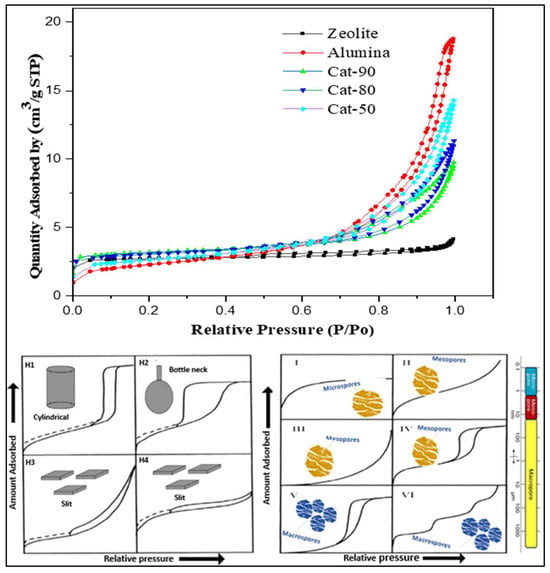
Figure 1.
N2 adsorption–desorption isotherms of the zeolite, alumina, and their composite catalysts. IUPAC classified hysteresis and isotherm models.

Table 2.
BET surface area, pore volume, and pore diameter of various catalysts.
2.2. Cracking Zeolite/γ-Al2O3 Binder Mixtures: X-Ray Diffraction Analysis
Figure 2 presents the XRD patterns of γ-alumina, zeolite, and their composite catalysts. A noticeable decrease in the intensity of the zeolite’s characteristic peaks upon alumina incorporation suggests successful integration of alumina into the catalyst framework.
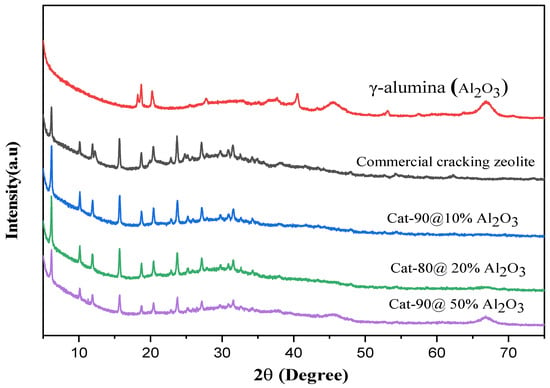
Figure 2.
X-ray diffraction patterns of zeolites/binder mixtures.
2.3. Catalytic Performance of Cracking Zeolite and Its Alumina Binder Composite Catalysts
To investigate the catalytic performance of various cracking zeolite-based catalysts in the neutral hydrolysis of waste PET, five distinct catalysts were prepared with different alumina loadings: Cat-100, Cat-90, Cat-80, Cat-50, and Cat-0 (Alumina). Figure 3 shows the yields of the hydrolysis reaction, which were 78.83%, 81%,79.1%, 75.78% and 71.4%, respectively. The trend with increased Al2O3 binder in the catalysts generally led to lower TPA yield. To evaluate the levels of Bronsted and Lewis acid sites in the prepared zeolite-based cracking catalysts, NH3-TPD analysis was conducted on zeolite-based samples containing varying ratios of Al2O3 binder. As reported in previous research, Bronsted and Lewis acidic sites in the zeolite framework can be differentiated by the temperature of the peak in the NH3-TPD curves []. Lewis acid sites were observed in the low-temperature range (below 300 °C), whereas those associated with Bronsted acid sites emerged at higher temperatures (above 300 °C) []. The overall acidity of the zeolite-based cracking catalysts was determined by integrating the NH3-TPD profiles, with the resulting total acid site concentrations summarized in Table 3. The measured total acid site concentrations were 0.666, 0.3248, 0.2961, and 0.2446 mmol/g for Cat-100, Cat-90, Cat-80, and Cat-50, respectively, suggesting variations in the acidic site concentrations that could influence catalytic activity.
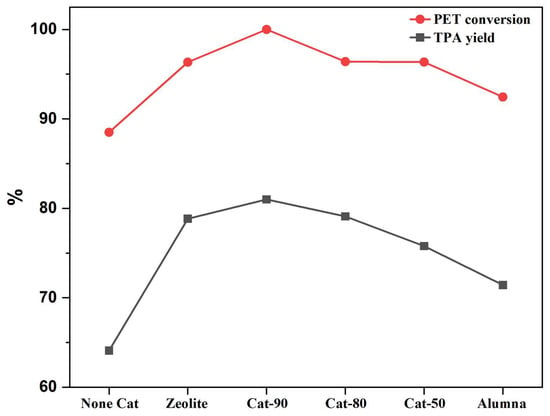
Figure 3.
Influence of addition of alumina binder to cracking catalysts on PET conversion and TPA yield [Temperature:210 °C, catalyst 2.86% wt., 8 h].

Table 3.
Acid Site Types and Concentrations on Zeolite-Based Cracking Catalysts Determined by NH3-TPD.
The Bronsted to Lewis (BAS/LAS) acidic site ratios were calculated for each catalyst, yielding values of 2.9, 0.38, 0.324, and 0.2866, respectively. Notably, Cat-90 exhibited the highest yield, suggesting that the introduction of 10% alumina may have optimized the catalytic activity. This phenomenon can be attributed to several factors: Firstly, the presence of alumina can modify the acidic properties of the cracking zeolite, potentially enhancing the availability of active sites for the hydrolysis reaction. The optimal alumina loading in Cat-90 may have created a favorable balance between Bronsted and Lewis acid sites, facilitating the hydrolysis process more effectively than either extreme of 0% or 50% alumina. Also, the introduction of alumina may improve the accessibility of the active sites within the cracking zeolite framework. A moderate amount of alumina could prevent excessive pore blockage, which can occur at higher loadings, thus allowing for better diffusion of reactants and products during the hydrolysis reaction. The stability of the catalyst can also play a role in its performance. Cat-90 may have exhibited better structural integrity under reaction conditions, leading to sustained catalytic activity compared to the other catalysts. The trend of Acidic Site Concentration indicates a decrease in acidic site concentration with increasing alumina content. This observation aligns with the general understanding that higher alumina loading can dilute the zeolitic acid sites, thereby reducing the overall acidity of the catalyst [,]. However, the relationship between acidic site concentration and catalytic performance is not linear. For instance, despite having the highest concentration of acidic sites, Cat-100 did not yield the highest TPA production. This suggests that the mere presence of acidic sites is not sufficient for optimal catalytic activity; the nature and distribution of these sites are equally important. Furthermore, the BAS/LAS ratios reveal a critical insight into the reaction mechanism. Cat-100 (pure zeolite) is heavily dominated by Brønsted acid sites (BAS/LAS ratio = 2.9), whereas the addition of 10% alumina in Cat-90 creates a much more balanced acidic environment (BAS/LAS ratio = 0.38). The superior yield of Cat-90, despite its lower total acidity, suggests a synergistic mechanism is required for efficient hydrolysis. We propose that Brønsted Acid Sites (BAS) are essential for initiating the reaction by protonating the carbonyl groups of the PET ester linkages. This step is crucial for lowering the activation energy (Ea) of the nucleophilic attack by water, and Lewis Acid Sites (LAS) play a distinct and vital role in stabilizing the carbocation intermediates formed during this attack. Therefore, the balanced profile of Cat-90 provides an optimal synergy of both functions. While Cat-100 has abundant Brønsted sites to lower (Ea), its performance is likely limited by an insufficient number of Lewis sites to stabilize the reaction intermediates. The balanced Cat-90 catalyst, however, provides sufficient BAS to initiate the reaction and sufficient LAS to stabilize it, leading to a more efficient overall pathway and a higher TPA yield. This finding underscores that the quality and balance of acid sites, not just the total quantity, are pivotal for this reaction. Figure 4 illustrates the relationship between the acidic site concentration of the zeolite-based cracking catalysts and the TPA yield obtained from the neutral hydrolysis of waste PET. Notably, Cat-90 showed a higher TPA yield than Cat-80, Cat-50, and even Cat-100, despite Cat-100 having a higher total acid site concentration. This can be attributed to the optimal loading of alumina, which promotes a higher concentration of Bronsted acid sites with greater acid strength compared to Lewis sites under aqueous conditions. Consequently, Cat-90, identified as the most acidic catalyst in this study, exhibited superior catalytic performance in the hydrolysis of waste PET. Although NH3-TPD provides indirect but supportive evidence for this balance, we acknowledge that techniques like Pyridine-IR or DRIFTS would offer more definitive quantification of BAS and LAS. Due to current experimental limitations, these techniques were not included in the present study but are part of our ongoing investigations.
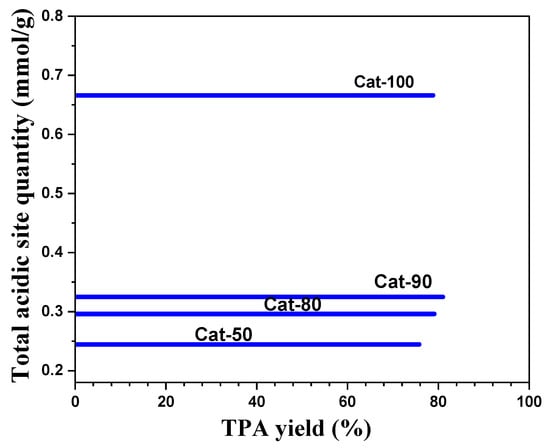
Figure 4.
TPA yield of the cracking zeolite-based catalysts and their acidic site concentration plot.
2.4. Impact of Catalyst Loading of Cat-90 @10%Alumina
The influence of catalyst loading on the depolymerization of PET was systematically examined by varying the concentration of Cat-90@10% Alumina from 1 to 5 wt.% at 210 °C. The results revealed that the reaction efficiency is highly sensitive to catalyst dosage. As shown in Figure 5, increasing the catalyst loading from 1 wt.% led to a sharp rise in both PET conversion and terephthalic acid (TPA) yield, reaching optimal performance at 3 wt.%. At this loading, a near-quantitative PET conversion of 99.5% and a maximum TPA yield of ~91% were obtained, demonstrating what appears to be a favorable balance between active catalytic sites and reactant availability. However, further increases beyond 3 wt.% proved detrimental; at 4 and 5 wt.%, both conversion and yield declined significantly. This inhibitory effect at higher concentrations can be attributed to multiple factors, including increased slurry viscosity causing mass-transfer resistance, agglomeration of catalyst particles reducing effective surface area, and the possible promotion of undesired side reactions consuming the target TPA. Collectively, these findings establish 3 wt.% as the optimal catalyst loading, as insufficient catalyst limits the reaction rate, whereas excessive amounts impede efficiency, likely due to mass transfer limitations or particle agglomeration.
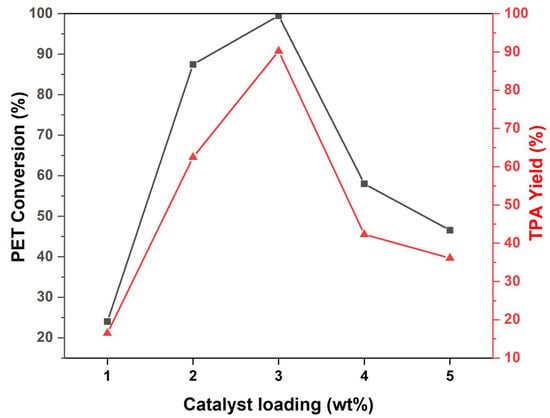
Figure 5.
Impact of Catalyst loading on the PET hydrolysis [temperature:210 °C, Cat-90@10%alumina, 6 h].
2.5. Effect of Reaction Conditions
2.5.1. Effect of Reaction Time on Neutral Hydrolysis of PET
Figure 6 illustrates the effect of reaction time on PET conversion and TPA yield during neutral hydrolysis. The results showed a clear upward trend in TPA yield with increasing reaction time from 2 to 8 h. At 2 h of hydrolysis, the TPA yield is relatively low at 4.164%, indicating that the reaction had just begun and significant PET depolymerization had not occurred yet. As the hydrolysis time increases to 4 and 6 h, there is a substantial increase in TPA yield, with values of 43.04% and 78.671%, respectively. This suggests that more PET was being depolymerized into TPA as the reaction progressed. Finally, at 8 h of hydrolysis, the conversion was achieved at 100%, and the TPA yield reached 81%. The low conversion of PET flakes during the initial 2 h is attributed to PET’s limited solubility in water, which restricted the neutral medium from sufficiently swelling the PET surface. However, the majority of PET conversion to TPA took place within the first 4 h; a notable rise was observed as the reaction time was increased further.
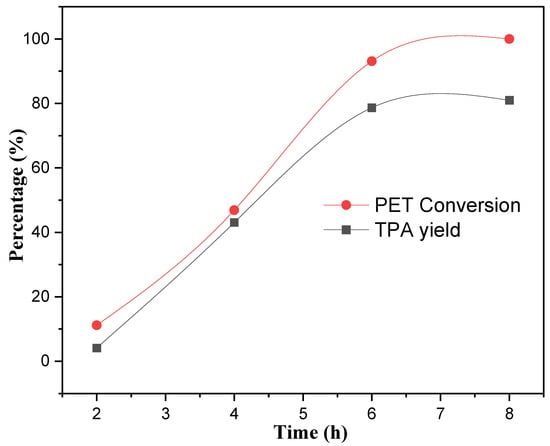
Figure 6.
Effect of reaction time on the hydrolysis of PET (temperature:210 °C, catalyst [Cat-90@10% alumina]: 2.86% wt).
2.5.2. Effect of Temperature on Neutral Hydrolysis Reaction of Waste PET
Figure 7 shows the effect of reaction temperature on PET conversion and TPA yield. The data showed a clear trend: as the temperature rose, the TPA yield also increased significantly. This suggests the hydrolysis reaction was strongly temperature-dependent under these conditions. To further investigate the catalyst’s performance at lower temperatures, additional experiments were conducted at 180 °C and 200 °C. At 180 °C, no significant reaction was observed, indicating that this temperature is below the activation threshold for effective depolymerization under these conditions. At 200 °C, the reaction proceeded at a slower rate compared to 210 °C, but the catalyst (Cat-90) still demonstrated significant activity and selectivity for TPA formation. The yield improved from 4.164% at 210 °C to 25.45% at 220 °C, which is approximately a 6-fold increase. Further increasing the temperature to 230 °C resulted in a yield of 55.53%, more than doubling the yield obtained at 220 °C. A significant increase in the PET conversion and TPA yield was observed with increasing reaction temperature. The conversion of PET showed a clear and rapid increase from 11.2% to 72.26% when the temperature increased from 210 °C to 230 °C. These findings are crucial for industrial recycling processes where maximizing the yield of PET hydrolysis is often desirable. Higher temperatures markedly enhanced process efficiency. However, higher temperatures also meant higher energy consumption and potential degradation of the PET or the formation of unwanted by-products. Thus, a balance must be struck between achieving high yields and managing operational costs and product quality.
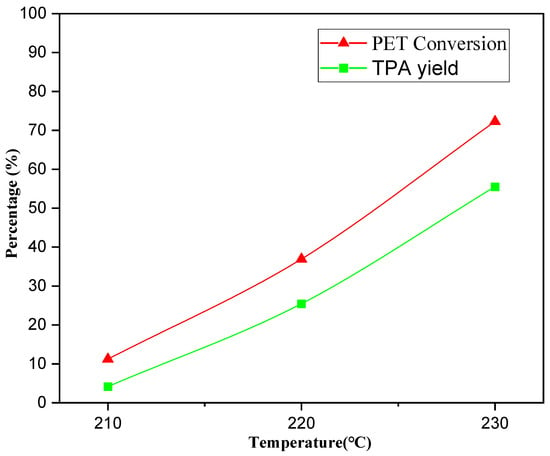
Figure 7.
Influence of Reaction Temperature on PET Hydrolysis (catalyst [Cat90@10% alumina]: 2.86% wt, 2 h).
2.5.3. Effect of the PET/Water Ratio on the Conversion of PET and TPA Yield
The effect of the weight ratio of water to PET on the neutral hydrolysis reaction at autogenous pressure for 6 h and at 210 °C are indicated in Figure 8. At the ratio of 1:2, the PET conversion percentage was 94.24%, indicating that a significant portion of PET had been depolymerized into TPA and ethylene glycol, and the TPA yield was 82.44%, suggesting that a substantial amount of TPA had been produced from the hydrolysis of PET at this ratio. With a slightly higher ratio of water to PET compared to the previous condition, the hydrolysis reaction may proceed more efficiently. The PET conversion percentage increases to 95.9%, indicating greater depolymerization compared to the 1:2 ratio, and the TPA yield also increases to 86.27%, reflecting the higher efficiency of the hydrolysis reaction at this ratio. The PET conversion percentage continues to rise to 97.68%, and the TPA yield increases slightly to 87.32% at the ratio of 1:4, indicating more complete depolymerization of PET. The PET conversion percentage reaches its highest value at 99.5%, indicating almost complete breakdown of PET chains under these conditions and the TPA yield also increases to 90.24%, indicating a high efficiency of TPA production from the hydrolysis of PET at a ratio of of 1:5. In general, the data show that increasing the water to-PET ratio led to higher PET conversion percentages and TPA yields. This was likely because a higher concentration of water promoted the hydrolysis reaction, resulting in more efficient depolymerization of PET and higher production of TPA.
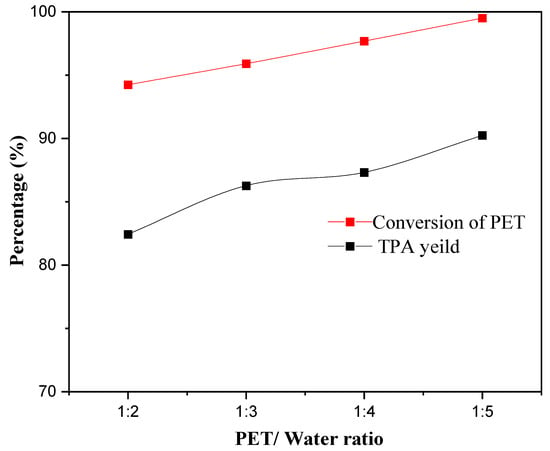
Figure 8.
Effect of the PET/water ratio on the hydrolysis of PET (temperature:210 °C, catalyst [Cat-90@10% alumina]: 2.86% wt, 6 h).
2.5.4. The Effect of Xylene as a Solvent on Neutral Hydrolysis of Waste PET
Xylene appeared to facilitate the formation of low-viscosity dispersions that were initially easy to mix, thereby enhancing the progress of depolymerization reactions. Additional benefits of using xylene include the straightforward separation of oligomers and excess water, as well as high product purity, due to the solubility of most degradation intermediates in the solvent. Figure 9 shows the TPA yield from the hydrolysis reaction at 210 °C, 6 h, and the PET/water mass ratio was 1:5 in the presence and absence of xylene. In the case of the presence of xylene, the TPA yield was 78.6%, and the value increased to 90.24% in the absence of xylene. The decreasing yield of terephthalic acid (TPA) when xylene is added to the neutral hydrolysis depolymerization of polyethylene terephthalate (PET) can be attributed to several interrelated factors. Firstly, the presence of xylene as a solvent can alter the reaction dynamics of PET hydrolysis. While xylene may have enhanced the solubility of PET and facilitated the reaction at lower temperatures, it may also have led to competitive reactions that divert the pathway toward TPA production. Specifically, xylene might have engaged in reactions resulting in the formation of oligomers or other by-products rather than TPA, thus reducing the overall yield of the desired product [,]. Crucially, the observed reduction in TPA yield in the presence of xylene (e.g., 78.6% with xylene vs. 90.24% without) is largely an apparent reduction due to the gravimetric measurement method employed. As confirmed by HPLC analysis of the xylene phase (Section 2.10), a significant portion of the formed TPA and its degradation intermediates dissolve into the xylene solvent. This dissolved fraction is not recovered during the subsequent purification and gravimetric weighing steps, thus leading to a lower recorded yield, rather than an actual decrease in TPA formation. Moreover, the interaction between xylene and the hydrolysis process may affect the kinetics of the reaction. Research indicates that incorporating organic cosolvents like xylene can favor glycolysis over hydrolysis, which is less favorable to maximizing TPA yields []. This shift in the reaction pathway can be detrimental, as glycolysis typically yields ethylene glycol (EG) and lower molecular weight oligomers rather than TPA. The competitive nature of these reactions suggests that the presence of xylene may inhibit the effective breakdown of PET into TPA, thereby decreasing the yield [,]. Additionally, the solubility and phase behavior of the reactants in the presence of xylene can influence the efficiency of the hydrolysis reaction. Xylene may have created an environment less conducive to PET hydrolysis by hindering the accessibility of water to the PET chains, which is crucial for effective depolymerization [,]. This phenomenon is particularly relevant when considering that the hydrolysis of PET is fundamentally a reaction that requires adequate water interaction to cleave the ester bonds effectively [,]. In summary, the addition of xylene to the neutral hydrolysis of PET likely led to decreased TPA yields due to promoting alternative reaction pathways, altering the kinetics of the hydrolysis process, affecting the solubility and phase behavior of the reactants and most of the degradation intermediates dissolved in xylene, which affects the final yield of TPA. These factors collectively contribute to the less efficient conversion of PET into TPA when xylene is present in the reaction medium. These conclusions are supported by the analysis the xylene phase after the reaction by HPLC discussed in Section 2.11 and Effect on TPA Yield.
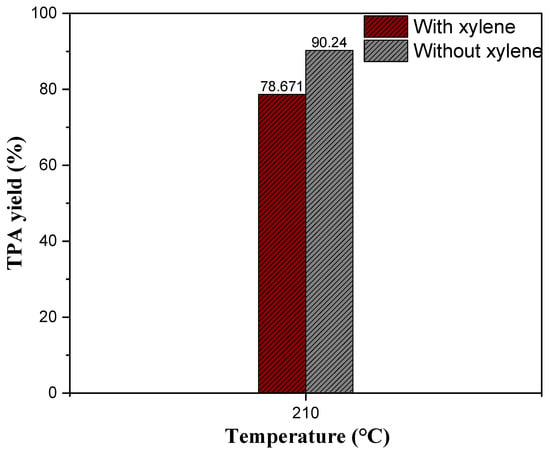
Figure 9.
Effect of xylene as solvent on the TPA yield via hydrolysis of PET at 210 °C, 6 h, and PET/water mass ratio was 1:5.
2.6. Catalytic Recyclability of Cat-90@10%Alumina
The recyclability and long-term stability of a catalyst are crucial for its viability in industrial-scale applications. The reusability of the Cat-90@10% Alumina catalyst was investigated for the depolymerization of PET. One of the significant advantages of this Zeolite-based catalyst is its ease of recovery from the reaction mixture through simple filtration, which allows for its straightforward separation and reuse. As illustrated in Figure 10, the performance of the Cat-90@10% Alumina catalyst was evaluated over five consecutive cycles. The fresh catalyst exhibited excellent activity in the first cycle, achieving nearly 100% PET conversion and a corresponding TPA yield of approximately 90%. However, in the subsequent cycles (2, 3, and 4), the catalyst showed a gradual but noticeable decline in performance. By the fourth cycle, the PET conversion had decreased to approximately 89%, and the TPA yield had dropped significantly to around 62%. This decrease in catalytic efficiency suggests a partial deactivation of the catalyst, which could be attributed to factors such as the fouling of active sites by reaction byproducts or the deposition of carbonaceous residues on the catalyst surface. After the fourth cycle, the catalyst was simply regenerated by annealing at 600 °C for 6 h. The regenerated catalyst showed a similar TPA yield to that of the fresh Cat-90@10%Alumina. The PET conversion and TPA yield were restored to approximately 97% and 88%, respectively. These values are almost identical to the performance of the fresh catalyst in the initial run. This successful regeneration indicates that the deactivation mechanism is largely reversible and that the structural integrity and active sites of the Cat-90@10% Alumina catalyst can be effectively restored. The ability to maintain high performance over multiple cycles, combined with a simple and effective regeneration protocol, highlights the robustness and potential of Cat-90@10% Alumina as a stable and economically attractive catalyst for the chemical recycling of PET.
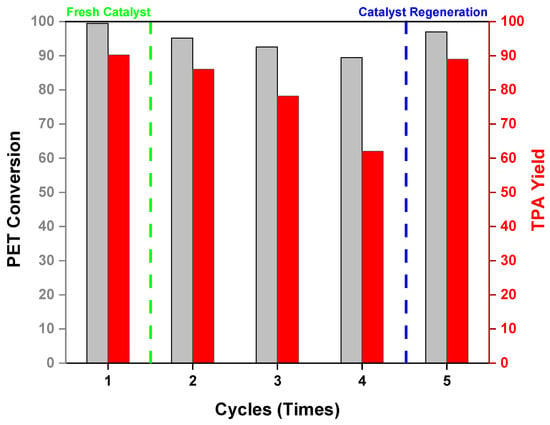
Figure 10.
Recyclability test results for the Cat-90@10% Alumina catalyst.
2.7. Reaction Mechanism of Neutral Catalytic Hydrolysis of PET
PET depolymerization via chemical hydrolysis initiates with the cleavage of ester linkages, producing oligomeric intermediates that are subsequently broken down into monomers. Since PET is insoluble in the reaction medium, hydrolysis predominantly occurs at the polymer’s surface, making surface area a key factor influencing reaction kinetics. In neutral hydrolysis, the catalyst’s acidity accelerates the reaction, which proceeds via a nucleophilic attack by water on the ester group. As supported by our catalytic performance data, this process is most efficient when there is a synergistic balance of Brønsted and Lewis acid sites. The mechanism involves two key functions provided by the catalyst: Brønsted acid sites generate hydroxonium ions that protonate the carbonyl group, lowering the activation energy (Ea) for the nucleophilic attack, while Lewis acid sites stabilize the carbocation intermediates formed during this process. This dual-site mechanism, in which BAS lowers the (Ea) and LAS provides stabilization, facilitates faster and more efficient reaction rates, with the subsequent steps proceeding along the standard ester hydrolysis pathway. Subsequent steps follow the standard ester hydrolysis pathway, yielding TPA and EG as the final products of PET hydrolysis [,]. Figure 11 illustrates the mechanism of PET hydrolysis. It is important to acknowledge that while our experimental observations and characterization data strongly support this proposed mechanism, we did not perform in situ spectroscopic studies (such as DRIFTS or in situ Raman spectroscopy) during the reaction. Such techniques would be required to directly observe the reaction intermediates or the dynamic changes on the catalyst surface, thereby providing definitive proof of the proposed mechanistic pathways. We suggest that further in situ mechanistic studies would be a valuable area for future research to gain a deeper and more conclusive understanding of the catalytic process.
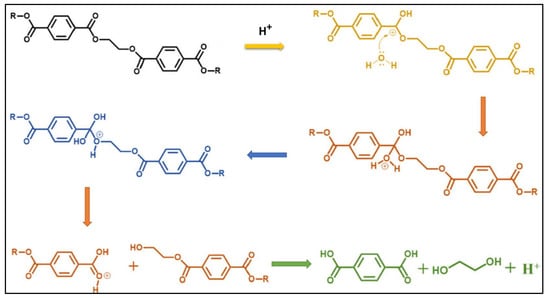
Figure 11.
PET hydrolysis mechanism with an acid catalyst.
2.8. Comparison of the TPA Melting of Fusion Temperatures
Figure 12 shows the melting temperatures of TPA produced from the depolymerization of PET using xylene as a solvent (384.93 °C) and without xylene (374.45 °C), revealing significant insights into the effects of solvent presence on the thermal properties of TPA. The observed decrease in melting point by 10.48 °C when xylene is absent suggests that the solvent plays a crucial role in influencing the crystallization behavior and thermal stability of TPA. It is important to distinguish between chemical purity, as measured by HPLC (e.g., 98.74% purity, as discussed in Section 2.9), and physical characteristics such as crystallinity, molecular packing, and crystal defects, which are reflected in the melting point determined by DSC. While HPLC confirms the high chemical purity of the synthesized TPA, the melting point provides insight into its solid-state structure. The presence of xylene during the depolymerization process likely facilitated a more efficient breakdown of the PET polymer chains, leading to a higher degree of purity and crystallinity in the resulting TPA. Solvents like xylene can act as plasticizers, which may have enhanced the mobility of polymer chains during the melting process, thus allowing for better packing and alignment of the crystalline structures in TPA []. This improved alignment can result in a higher melting temperature due to the increased energy required to disrupt the more ordered crystalline structure. Conversely, the absence of xylene may have led to less efficient crystallization, resulting in TPA with lower crystallinity and potentially more amorphous regions. The presence of amorphous regions in a polymer typically lowers the melting temperature, as these regions do not contribute to the ordered structure necessary for higher thermal stability []. This phenomenon is consistent with findings in other polymer systems where the melting temperature is influenced by the degree of crystallinity and the presence of amorphous phases []. Additionally, the thermal properties of TPA can be affected by the molecular weight and the distribution of molecular chains resulting from the depolymerization process. Higher molecular weights generally correlate with higher melting points due to the increased entanglement and interactions among polymer chains, which can be disrupted by the presence of solvents []. Therefore, the solvent’s role in controlling the molecular weight distribution during the depolymerization of PET is critical in determining the thermal properties of the resulting TPA. In summary, the significant difference in melting temperatures of TPA produced with and without xylene underscores the critical influence of solvent on the crystallization behavior and thermal stability of TPA. The presence of xylene appears to enhance the crystallinity and thermal properties of TPA, while its absence leads to a decrease in melting temperature, likely due to less efficient crystallization and the formation of more amorphous structures.
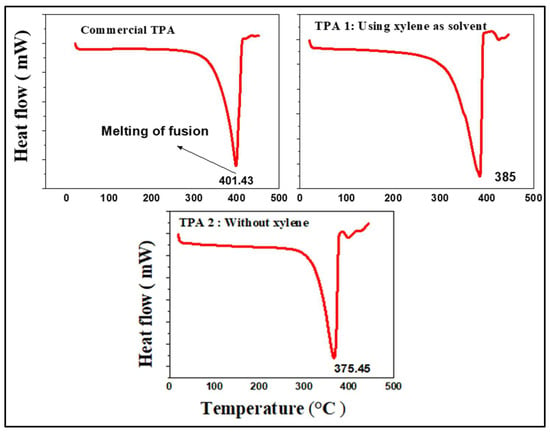
Figure 12.
DSC spectra of commercial TPA, TPA1, and TPA2 from a waste PET bottle.
2.9. FTIR Spectroscopy (Comparison of Recycled TPA via Standard TPA)
The FTIR spectrum of terephthalic acid (TPA) obtained from the hydrolysis of waste PET exhibits distinct absorption bands closely resemble those of pure TPA, as illustrated in Figure 13 and Table 4. Key peaks appear at 3061 cm−1 (aromatic C-H stretching), 1680 cm−1 (C=O stretching), 1280 cm−1 (C-O stretching), and 1136 and 1112 cm−1 (C-C stretching), reflecting the functional groups present in the synthesized compound. The absorption at 3061 cm−1 is particularly indicative of aromatic C-H vibrations, confirming the retention of the aromatic ring structure. These spectral similarities suggest that the hydrolysis process preserved the core aromatic structure of TPA []. The C=O stretching vibration observed at 1680 cm−1 is indicative of the carbonyl group present in TPA, which is crucial for its chemical properties and reactivity []. This peak is typically found in the FTIR spectrum of pure TPA, affirming that the hydrolysis process retained the carbonyl functionality. The C-O stretching peak at 1280 cm−1 is also a characteristic feature of TPA, reflecting the ester functionality that remains intact during the hydrolysis of PET []. The presence of C-C stretching peaks at 1136 and 1112 cm−1 further supports the integrity of the aromatic structure, as these vibrations are associated with the carbon backbone of TPA. The retention of these peaks in the FTIR spectrum of TPA produced from PET hydrolysis suggests that the hydrolysis process did not lead to significant degradation of the TPA structure.
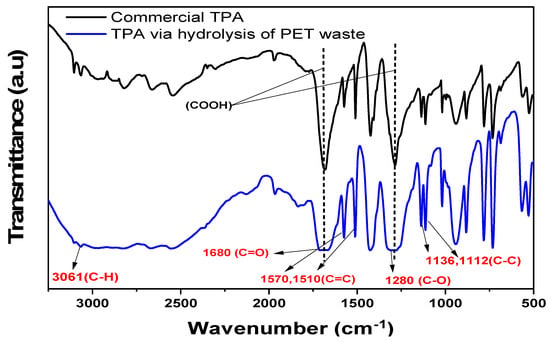
Figure 13.
FTIR-spectra of the obtained TPA in comparison with the commercial TPA standard.

Table 4.
FTIR data of TPA obtained via the hydrolysis of waste PET.
2.10. Purity Analysis of TPA by HPLC
The HPLC analysis results, indicating a range of purities for the TPA samples, are shown in Table 5, with values such as 98.74% and 98.5% among the highest purities recorded. A distinct, sharp TPA peak was detected at a retention time (RT) of 1.9 min, as shown in Figure 14. These high purity levels suggest the effectiveness of the purification process was effective in removing contaminants, as supported by the literature that emphasizes the importance of purification in achieving high-quality monomers from PET []. The calibration curve established during the HPLC analysis further validated the reliability of the quantification method used, ensuring that the reported purity values are accurate and reproducible []. Moreover, the conditions under which the HPLC analysis was performed, specifically, the use of a ZORBAX Eclipse Plus C18 column and a well-defined eluent composition, were critical for achieving optimal separation and detection of TPA. The choice of a photodiode array (PDA) detector allows for precise monitoring of TPA concentrations, reinforcing the robustness of the employed analytical method []. The flow rate and column temperature were also optimized to enhance the resolution of the chromatographic separation, which was crucial for accurately assessing the purity of the final product [].

Table 5.
HPLC analyzed results for all TPA samples and their purities.
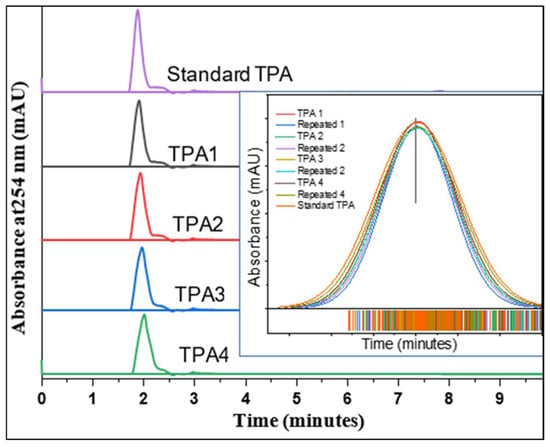
Figure 14.
HPLC analysis of solutions of standard TPA and TPAs from neutral hydrolysis of waste PET, in 60% water, 30% acetonitrile, 10% methanol, and 0.5% DMSO.
2.11. HPLC Analysis of Separated Xylene Phase
Upon completing the reaction, analysis of the xylene phase using HPLC revealed several additional peaks compared to pure xylene. These new peaks likely correspond to dissolved TPA and/or its derivatives formed during the reaction. This indicates that xylene is not merely a passive solvent but is involved in the dissolution of reaction intermediates []. The presence of TPA and its derivatives in the xylene phase suggests that these compounds partitioned, are partitioning into the xylene phase rather than remaining in the aqueous phase, where they could have undergone further transformations to yield the final TPA product.
Effect on TPA Yield
The decrease in TPA yield in the presence of xylene could be attributed to dissolved TPA and its derivatives in the xylene phase being removed from the reaction mixture, reducing the concentration of TPA available for recovery. It is possible that during the reaction, some TPA intermediates (such as mono-hydroxy or di-hydroxy TPA derivatives) or even unreacted PET fragments dissolve into the xylene solvent, where they remain unreacted or are less efficiently converted into TPA (Figure 15). This partitioning effect explains the lower TPA yield observed when xylene is used as a solvent. Essentially, instead of accumulating in the desired product phase (likely the aqueous phase), the intermediates are transferred to the xylene phase, where they are likely not as readily converted to TPA or recovered. Furthermore, some of the TPA derivatives dissolved in xylene could have acted as side-products or inhibitors hindering the final stages of TPA production or extraction. If these derivatives are not stable or are less reactive, they could act as chemical blockers, decreasing the overall efficiency of the process []. In summary, the decrease in TPA yield in the presence of xylene is likely to be attributed to the solvent’s ability to dissolve TPA and its derivatives, removing them from the reaction medium where they could otherwise have been recovered. The dissolution of intermediates into the xylene phase decreases the availability of the desired product in the reaction medium, thus lowering the overall efficiency of TPA production. Further optimization of solvent choice or phase separation techniques could potentially mitigate this effect and improve the overall yield of the hydrolysis process.
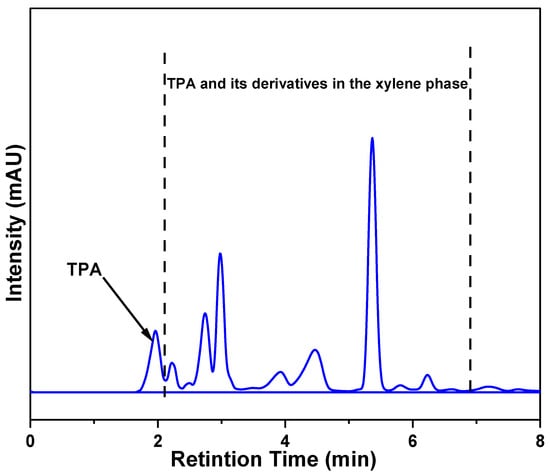
Figure 15.
HPLC analysis of the xylene phase which used as a solvent during the hydrolysis of PET.
2.12. GC-MS Analysis of Separated Xylene Phase
Upon completion of the reaction, HPLC analysis of the xylene phase revealed additional peaks attributed to dissolved TPA and its derivatives, shown in Figure 16 and Figure 17, indicating that these intermediates were not confined to the aqueous phase but also partitioned into xylene. Subsequent GC-MS analysis confirmed the presence of BHET, various terephthalate esters, and phthalate-related species within the organic layer, demonstrating that xylene not only extracted but also retained a significant portion of PET hydrolysis products. This partitioning effect explains the decreased TPA yield observed during hydrolysis, TPA and its intermediates dissolve into the xylene phase, rather than accumulating in the aqueous layer where further conversion or recovery could have occurred. As a result, the effective concentration of TPA available for isolation is reduced, and some derivatives in xylene may have acted as side-products or inhibitors, further diminishing the overall process efficiency.
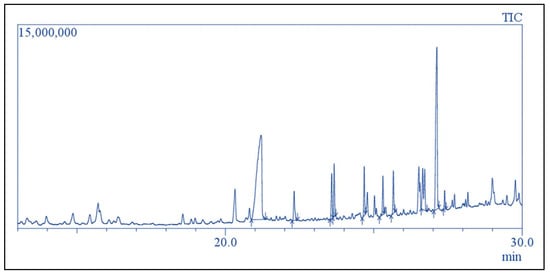
Figure 16.
GC-MS analysis of the xylene phase, which used as a solvent during the hydrolysis of PET.

Figure 17.
Structures and Percentages of Main PET Hydrolysis Products detected in Xylene phase.
3. Materials and Methods
3.1. Materials
Waste PET, approximately 2 mm × 2 mm flake size; Xylene (99%, pure, Acros Organics, Antwerpen, Belgium); Methanol (HPLC grade, Panreac, Barcelona, Spain); Acetonitrile (purity 99.99%, LiChrosilve, Merck, Kenilworth, NJ, USA); Dimethyl sulfoxide (DMSO Analytical grade); Sodium hydroxide pellets (NaOH, Extra pure, Lobachemie, Mumbai, India); Hydrochloric acid (HCl, Sigma-Aldrich, St. Louis, MO, USA); Aluminum oxide (Al2O3 nanopowder, <50 nm particle size (TEM), gamma phase, Sigma-Aldrich), and commercial cracking catalyst (Zeolite, USA).
3.2. Experimental Setup
The hydrolysis reaction was performed in a 100 mL stainless steel batch autoclave reactor fitted with a stirrer, operating under controlled temperature and pressure conditions. The neutral catalytic hydrolysis procedure included the following steps:
3.3. Poly (Ethylene Terephthalate) Flakes Preparation
Post-consumer PET water bottles were sourced from household waste streams. Following the removal of caps and labels, the bottles were manually cut into small fragments using scissors to prepare them for further processing. These small pieces of PET were fed into crab-ball milling to obtain the targeted granular size of 8–10 mesh using liquid nitrogen.
3.4. Catalyst Preparation
A commercial cracking catalyst (Zeolite) and gamma alumina (γ-Al2O3) were used as composite mixed catalysts. The catalysts were prepared by blending the cracking Zeolite with 10, 20, and 50% of γ-Al2O3 binder in dry form. Later slurries of the composites were prepared by adding distilled water to the composite mixtures. The prepared slurries were stirred for 2 h and then allowed to stand at ambient temperature for an additional 2 h. Subsequently, the samples were dried at 120 °C for 12 h and subjected to calcination at 500 °C for 3 h. The resulting catalysts were stored in airtight containers until further use (Table 6 and Table 7).

Table 6.
Properties of cracking catalyst (zeolite).

Table 7.
Catalysts with different zeolite and γ-Al2O3 ratios.
3.5. Catalyst Loading Experiment Procedure
To determine the optimal catalyst loading for PET neutral hydrolysis, a series of experiments was conducted in which the dosage of Cat-90@10% alumina was systematically varied from 1 to 5 wt.% relative to the PET mass. Each reaction was performed in a 100 mL stainless steel batch autoclave containing 5 g of PET flakes, deionized water (in a defined PET/water ratio), and the specified amount of catalyst. The reactor was sealed and heated to 210 °C under continuous stirring (500 rpm) for 6 h. Upon reaction completion, the mixture was filtered to recover solid and liquid fractions. Terephthalic acid (TPA) was recovered and weighed, and PET conversion and TPA yield were determined gravimetrically. The effect of catalyst dosage on PET conversion and TPA yield was carefully monitored.
3.6. PET Recycling
The hydrolysis reaction was achieved using a 100 mL stainless steel batch-type autoclave reactor fitted with a stirrer (500 rpm). To recycle PET,5 g of waste PET flakes measuring 2 mm × 2 mm was mixed with deionized water at varying ratios of 1:2, 1:3, 1:4, and 1:5. The minimum water quantity required to achieve complete PET depolymerization was 5.1 g of water/g of PET [,], and 40 mL of xylene as a solvent in the presence of 0.143 g of catalysts (2.8% by weight of PET) for a time period varying up to 8 h.
3.7. Catalyst Reusability Assessment
The reusability of the Cat-90@10% alumina catalyst was carefully examined to evaluate its long-term performance. The optimized protocol involved the use of 3 wt.% Cat-90@10%alumina relative to PET, as this dosage provided the most favorable balance between PET conversion and TPA yield. After each hydrolysis run, the catalyst was recovered through simple filtration, washed, dried, and reused for subsequent cycles under identical conditions. The experiment was carried out for 5 cycles. The catalyst maintained high activity during the first three cycles with minimal loss in PET conversion and TPA yield. After four operating cycles, slight deactivation was observed, primarily attributed to fouling of active sites. Simple regeneration by annealing at 600 °C for 6 h fully restored catalytic performance to nearly the original level, demonstrating easy recoverability and durability over multiple cycles.
3.8. TPA Recovery and Purification
Upon completion of the reaction, the reaction mixture was removed from the reactor vessel and subjected to vacuum filtration to separate the liquid phase from solid residues. The liquid phase contained the produced EG and xylene. To separate xylene and ethylene glycol, the mixture was transferred to a separating funnel. Since the two liquids are immiscible, they form two distinct layers within the funnel. The lower layer, consisting of EG, was carefully drained. The solid residue, comprising unreacted PET, formed TPA, and catalyst, was treated with 1 M NaOH solution for 15 min to convert the TPA into its soluble sodium salt (Na2-TPA). The resulting sodium terephthalate solution was then acidified with a twofold molar excess of 2 M HCl to precipitate TPA. The resulting white precipitate was subsequently filtered, air-dried at room temperature for 12 h, and oven-dried at 80 °C for 5 h. The purified TPA was stored in sealed containers for subsequent chemical analysis. It is important to note that the TPA yield reported in this study was determined gravimetrically from this recovered solid TPA. Any TPA or TPA derivatives that remained dissolved in the xylene (organic) phase were not quantified or included in this yield calculation.
3.9. Chemical Analysis
The purity of the recovered TPA was assessed using HPLC, while its molecular structure was verified through FTIR spectroscopy. The degree of crystallinity was evaluated using differential scanning calorimetry (DSC).
3.10. Calibration Curve
For the HPLC analysis of TPA, a comprehensive calibration curve is shown in Table 8, established under the following conditions: The eluent used was 60% water, 30% acetonitrile, 10% methanol, and 0.5% DMSO, using an analytical ZORBAX Eclipse Plus C18 analytical column (Agilent Technologies, Santa Clara, CA, USA, 4.6 × 250 mm, 5 μm) was employed. The mobile phase was delivered at a flow rate of 1.0 mL/min, and detection was performed using a photodiode array (PDA) detector (Agilent Technologies). The column temperature was kept constant at 35 °C to maintain optimal separation. A stock solution was prepared by dissolving 5 mg of high-purity TPA (Aldrich) in 10 mL of methanol. Calibration standards were obtained by diluting 10, 20, 30, 40, 50, and 60 μL of the stock solution with methanol to a final volume of 1000 μL, yielding standard concentrations from 10 to 60 mg/L. For sample analysis, 50 µL of each sample was diluted with 950 µL of methanol. This method ensured precise quantification of TPA, providing a robust calibration curve with a correlation coefficient (r) exceeding 0.999, allowing for accurate quantification of TPA in various test samples.

Table 8.
Standard solutions and their peak area for the calibration curve.
4. Analysis of Results
4.1. Quantitative Analysis
The reaction extent was quantitatively evaluated based on the percent yield of TPA and the conversion of PET. The TPA yield was determined gravimetrically by weighing the dried TPA recovered after precipitation from the filtrate, as described in Equation (1). The percentage conversion of PET was calculated from the mass of PET flakes collected, dried, and weighed after the reaction had concluded. The calculations for PET conversion and TPA purity were performed according to Equations (2) and (3), respectively.
4.2. Analytical and Characterization Methods
4.2.1. Surface Area Analysis
The surface area and porosity of the fresh catalyst samples were characterized using a Micromeritics TriStar II 3020 analyzer (Norcross, GA, USA). Nitrogen (N2) physisorption was conducted at −196 °C. Before analysis, approximately (0.2–0.3 g) of each sample was degassed at 250 °C for 3 h under a nitrogen atmosphere to eliminate surface moisture and adsorbed gases. The Brunauer–Emmett–Teller (BET) method was employed to calculate the specific surface area, while the Barrett–Joyner–Halenda (BJH) model was applied to determine the pore volume.
4.2.2. X-Ray Diffraction (XRD)
Wide-angle X-ray diffraction (XRD) was used to evaluate the long-range order of alumina, zeolite, and their composite catalysts. Patterns were acquired using Cu-Kα radiation on a Bruker D8 Discover diffractometer (Billerica, MA, USA), scanning from 5° to 85° (2θ) in continuous mode at 20 kV and 5 mA. The scan employed a 0.2° step size, 3-s dwell time, and a rate of 4°/min.
4.2.3. Temperature Programmed Desorption (TPD)
Ammonia temperature-programmed desorption (NH3-TPD) analysis was performed using a Micromeritics Autochem II 2920 chemisorption analyzer (Norcross, GA, USA) equipped with a thermal conductivity detector (TCD). Each catalyst sample (50 mg) was initially pretreated under a helium atmosphere at 200 °C for 1 h to remove physiosorbed impurities, followed by cooling to room temperature. Ammonia adsorption was carried out at 50 °C for 60 min using a helium-ammonia gas mixture at a flow rate of 25 mL/min. Desorption was then conducted by heating the sample up to 700 °C at a rate of 10 °C/min, with NH3 desorption monitored via the TCD.
4.2.4. Differential Scanning Calorimetry (DSC)
DSC was employed to study the melting characteristics of the produced TPA using a TA Instruments 60WS thermal analyzer (New Castle, DE, USA). The sample was initially heated from 20 °C to 450 °C at a rate of 10 °C/min, held isothermally at 450 °C for 3 min to eliminate any prior thermal history, and then reheated to 450 °C at the same heating rate to capture the melting endothermic peak. All measurements were carried out under a nitrogen atmosphere to prevent oxidative degradation.
4.2.5. High-Performance Liquid Chromatography (HPLC)
Terephthalic acid (TPA) was quantified using high-performance liquid chromatography (HPLC) on a Shimadzu RID-10A series system (Shimadzu Co., Kyoto, Japan), utilizing an Agilent ZORBAX Eclipse Plus C18 column (Shanghai, China, 4.6 × 250 mm, 5 μm). The injection volume was set at 20 μL, with the column maintained at 35 °C and the mobile phase delivered at a flow rate of 1 mL/min. The eluent composition was 60% water, 30% acetonitrile, 10% methanol, and 0.5% dimethyl sulfoxide (DMSO).
4.2.6. Fourier Transform Infrared Spectroscopy (IR-FTIR)
FTIR spectroscopy was utilized to investigate the molecular structure of the recovered terephthalic acid (TPA). The identification of pure TPA was further supported by proton and carbon NMR spectra of the monomer mixture resulting from PET hydrolysis. spectra were obtained using a Shimadzu IR-Prestige-21 spectrophotometer (Kyoto, Japan) over the range of 400 to 4000 cm−1, with a resolution of 4 cm−1. The samples were prepared in the form of KBr pellets.
4.2.7. GC-MS Analysis
After PET hydrolysis, the xylene layer was analyzed by GC/MS. A QP2010 Ultra GC/MS apparatus (Shimadzu, Kyoto, Japan) with a Rtx 5MS column, crossbond 5% diphenyl/95% dimethyl polysiloxane (30 m length, 0.25 mm internal diameter, 0.25 μm film thickness) was used. The injector temperature was 250 °C. The oven temperature was initially 140 °C, then increased at 5 °C/min up to 200 °C, then increased at 10 °C/min up to 300 °C and kept there for 3 min. The flow rate of the helium carrier gas was 1.7 mL/min with a splitless mode. The mass spectrometer was operated at 300 °C in positive electron impact mode with an ionization energy of 70 eV, a m/z range of 50 to 500, and a scan speed of 1666 scans/min. The GC-MS solution integrated software (Shimadzu Cat. No. 225-21731-92) was used for the chromatogram analysis. The NIST11 library and the NIST analysis software (MODEL NIST11 LIBRARY, CAT. NO. 225-21772-91, SERIAL NO. 020675102139 SL) were also used for the interpretation of the mass spectra and the identification of the xylene phase.
5. Conclusions
This study presents an effective and sustainable method for PET chemical recycling via neutral catalytic hydrolysis. Using alumina-modified zeolite (Cat-90, 10% alumina), the process achieved a high TPA yield (90.24%) and nearly complete depolymerization (99.5%) at 210 °C for 6 h, with optimal performance attributed to the balanced Bronsted and Lewis acid sites and improved catalyst stability. Xylene was found to enhance TPA crystallization, increasing its melting point to 384.93 °C, though its presence apparently reduced the measured yield by dissolving TPA and intermediates. FTIR confirmed that hydrolysis preserved key structural features of TPA, while HPLC analysis showed high-purity TPA (up to 98.7%) was obtained through optimized purification. Key factors influencing efficiency included reaction time, temperature, and the water-to-PET ratio, with a 5:1 ratio offering the best results. These findings support the development of energy-efficient, high-yield PET recycling strategies aligned with circular economy goals. Critically, our extended investigation revealed that a catalyst loading of 3 wt% Cat-90@10%Alumina provides an optimal balance between catalytic activity and mass transfer, maximizing PET conversion and TPA yield. Higher catalyst dosages proved detrimental to performance due to increased viscosity and particle agglomeration. Furthermore, the catalyst demonstrated excellent recyclability: it retained high depolymerization performance over at least four cycles, and its activity could be efficiently restored by simple annealing at 600 °C, underscoring its regenerative capacity. The results highlight that catalyst acid site tuning, optimal loading, and efficient regeneration are all pivotal for the economic and environmental feasibility of industrial PET chemical recycling. Overall, the Cat-90@10%Alumina catalyst emerges as a highly active, stable, and recoverable material—offering a promising solution for large-scale, circular, and sustainable production of high-purity TPA from PET waste.
Author Contributions
S.S.A.: Conceptualization, Methodology, Investigation, Data Curation, Writing—Original Draft. W.A.-M.: Conceptualization, Supervision, Resources, Writing—Review and Editing, Project Administration, Funding Acquisition. A.S.A.-F.: Sample testing, Formal Analysis, Validation. S.H.: Data Curation, Formal Analysis, Visualization, Writing—Review and Editing. A.M.: Methodology, Software, Data Curation. L.E.B.: Investigation, Formal Analysis. A.B.J.: Conceptualization, Supervision, Resources, Writing—Review and Editing, Project Administration, Funding Acquisition. All authors have read and agreed to the published version of the manuscript.
Funding
This research was funded by the Ongoing Research Funding program (ORF-2025-557), King Saud University, Riyadh, Saudi Arabia.
Data Availability Statement
All data generated or analyzed during this study are included in this published article.
Conflicts of Interest
The authors declare no conflicts of interest.
References
- Stanica-Ezeanu, D.; Matei, D. Natural depolymerization of waste poly(ethylene terephthalate) by neutral hydrolysis in marine water. Sci. Rep. 2021, 11, 4431. [Google Scholar] [CrossRef]
- Damayanti; Wu, H.S. Strategic possibility routes of recycled pet. Polymers 2021, 13, 1475. [Google Scholar] [CrossRef]
- Chiu, S.J.; Cheng, W.H. Thermal degradation and catalytic cracking of poly(ethylene terephthalate). Polym. Degrad. Stab. 1999, 63, 407–412. [Google Scholar] [CrossRef]
- Noritake, A.; Hori, M.; Shigematsu, M.; Tanahashi, M. Recycling of polyethylene terephthalate using high-pressure steam treatment. Polym. J. 2008, 40, 498–502. [Google Scholar] [CrossRef]
- Pudack, C.; Stepanski, M.; Fässler, P. PET Recycling—Contributions of Crystallization to Sustainability. Chem. Ing. Tech. 2020, 92, 452–458. [Google Scholar] [CrossRef]
- Peng, Y.; Yang, J.; Deng, C.; Deng, J.; Shen, L.; Fu, Y. Acetolysis of waste polyethylene terephthalate for upcycling and life-cycle assessment study. Nat. Commun. 2023, 14, 3249. [Google Scholar] [CrossRef] [PubMed]
- Shojaei, B.; Abtahi, M.; Najafi, M. Chemical recycling of PET: A stepping-stone toward sustainability. Polym. Adv. Technol. 2020, 31, 2912–2938. [Google Scholar] [CrossRef]
- Goje, A.S.; Thakur, S.A.; Patil, T.M.; Mishra, S. Glycolytic Aminolysis of Poly(ethylene terephthalate) Waste for Recovery of Value-Added Comonomer at Atmospheric Pressure. J. Appl. Polym. Sci. 2003, 90, 3437–3444. [Google Scholar] [CrossRef]
- Acar, I.; Bal, A.; Güçlü, G. The use of intermediates obtained from aminoglycolysis of waste poly(ethylene terephthalate) (PET) for the synthesis of water-reducible alkyd resin. Can. J. Chem. 2013, 91, 357–363. [Google Scholar] [CrossRef]
- Güçlü, G.; Orbay, M. Alkyd resins synthesized from postconsumer PET bottles. Prog. Org. Coat. 2009, 65, 362–365. [Google Scholar] [CrossRef]
- De Castro, R.E.N.; Vidotti, G.J.; Rubira, A.F.; Muniz, E.C. Depolymerization of poly(ethylene terephthalate) wastes using ethanol and ethanol/water in supercritical conditions. J. Appl. Polym. Sci. 2006, 101, 2009–2016. [Google Scholar] [CrossRef]
- Karayannidis, G.P.; Achilias, D.S. Chemical recycling of poly(ethylene terephthalate). Macromol. Mater. Eng. 2007, 292, 128–146. [Google Scholar] [CrossRef]
- Karayannidis, G.P.; Chatziavgoustis, A.P.; Achilias, D.S. Poly(ethylene terephthalate) recycling and recovery of pure terephthalic acid by alkaline hydrolysis. Adv. Polym. Technol. 2002, 21, 250–259. [Google Scholar] [CrossRef]
- Mancini, S.D.; Zanin, M. Post Consumer Pet Depolymerization by Acid Hydrolysis. Polym.-Plast. Technol. Eng. 2007, 46, 135–144. [Google Scholar] [CrossRef]
- Yates, K.; McClelland, R.A. Mechanisms of ester hydrolysis in aqueous sulfuric acids. J. Am. Chem. Soc. 1967, 89, 2686–2692. [Google Scholar] [CrossRef]
- Yoshioka, T.; Sato, T.; Okuwaki, A. Hydrolysis of waste PET by sulfuric acid at 150 °C for a chemical recycling. J. Appl. Polym. Sci. 1994, 52, 1353–1355. [Google Scholar] [CrossRef]
- Yoshioka, T.; Okayama, N.; Okuwaki, A. Kinetics of Hydrolysis of PET Powder in Nitric Acid by a Modified Shrinking-Core Model. Ind. Eng. Chem. Res. 1998, 37, 336–340. [Google Scholar] [CrossRef]
- Grancarić, A.M.; Kallay, N. Kinetics of polyester fiber alkaline hydrolysis: Effect of temperature and cationic surfactants. J. Appl. Polym. Sci. 1993, 49, 175–181. [Google Scholar] [CrossRef]
- Bohre, A.; Jadhao, P.R.; Tripathi, K.; Pant, K.K.; Likozar, B.; Saha, B. Chemical Recycling Processes of Waste Polyethylene Terephthalate Using Solid Catalysts. ChemSusChem 2023, 16, e202300142. [Google Scholar] [CrossRef]
- Woolery, G.L.; Kuehl, G.H.; Timken, H.C.; Chester, A.W.; Vartuli, J.C. On the nature of framework Brønsted and Lewis acid sites in ZSM-5. Zeolites 1997, 19, 288–296. [Google Scholar] [CrossRef]
- Bui, L.; Luo, H.; Gunther, W.R.; Román-Leshkov, Y. Domino reaction catalyzed by zeolites with Brønsted and Lewis acid sites for the production of γ-valerolactone from furfural. Angew. Chem. Int. Ed. 2013, 52, 8022–8025. [Google Scholar] [CrossRef]
- Hargreaves, J.S.J.; Munnoch, A.L. A survey of the influence of binders in zeolite catalysis. Catal. Sci. Technol. 2013, 3, 1165. [Google Scholar] [CrossRef]
- Michels, N.-L.; Mitchell, S.; Pérez-Ramírez, J. Effects of Binders on the Performance of Shaped Hierarchical MFI Zeolites in Methanol-to-Hydrocarbons. ACS Catal. 2014, 4, 2409–2417. [Google Scholar] [CrossRef]
- Lee, K.-Y.; Lee, H.-K.; Ihm, S.-K. Influence of Catalyst Binders on the Acidity and Catalytic Performance of HZSM-5 Zeolites for Methanol-to-Propylene (MTP) Process: Single and Binary Binder System. Top. Catal. 2010, 53, 247–253. [Google Scholar] [CrossRef]
- Li, X.; Wang, C.; Liu, S.; Xin, W.; Wang, Y.; Xie, S.; Xu, L. Influences of alkaline treatment on the structure and catalytic performances of ZSM-5/ZSM-11 zeolites with alumina as binder. J. Mol. Catal. A Chem. 2011, 336, 34–41. [Google Scholar] [CrossRef]
- Kasture, M.W.; Niphadkar, P.S.; Bokade, V.V.; Joshi, P.N. On the catalytic performance in isopropylation of benzene over H/β zeolite catalysts: Influence of binder. Catal. Commun. 2007, 8, 1003–1008. [Google Scholar] [CrossRef]
- Etim, U.J.; Bai, P.; Wang, Y.; Subhan, F.; Liu, Y.; Yan, Z. Mechanistic insights into structural and surface variations in Y-type zeolites upon interaction with binders. Appl. Catal. A Gen. 2019, 571, 137–149. [Google Scholar] [CrossRef]
- Lefevere, J.; Protasova, L.; Mullens, S.; Meynen, V. 3D-printing of hierarchical porous ZSM-5: The importance of the binder system. Mater. Des. 2017, 134, 331–341. [Google Scholar] [CrossRef]
- Shihabi, D. Aluminum insertion into high-silica zeolite frameworks II. Binder activation of high-silica ZSM-5. J. Catal. 1985, 93, 471–474. [Google Scholar] [CrossRef]
- Maciver, D. Catalytic aluminas I. Surface chemistry of eta and gamma alumina. J. Catal. 1963, 2, 485–497. [Google Scholar] [CrossRef]
- Choudhary, V.R.; Devadas, P.; Kinage, A.K.; Guisnet, M. Influence of binder on the acidity and performance of H-Gallosilicate (MFI) zeolite in propane aromatization. Appl. Catal. A Gen. 1997, 162, 223–233. [Google Scholar] [CrossRef]
- Wu, X.; Alkhawaldeh, A.; Anthony, R.G. Investigation on acidity of zeolites bound with silica and alumina. Stud. Surf. Sci. Catal. 2000, 143, 217–225. [Google Scholar]
- Groen, J.C.; Peffer, L.A.A.; Pérez-Ramírez, J. Pore size determination in modified micro- and mesoporous materials. Pitfalls and limitations in gas adsorption data analysis. Microporous Mesoporous Mater. 2003, 60, 1–17. [Google Scholar] [CrossRef]
- AlAbduljabbar, F.A.; Haider, S.; Ali, F.A.A.; Alghyamah, A.A.; Almasry, W.A.; Patel, R.; Mujtaba, I.M. Efficient Photocatalytic Degradation of Organic Pollutant in Wastewater by Electrospun Functionally Modified Polyacrylonitrile Nanofibers Membrane Anchoring TiO2 Nanostructured. Membranes 2021, 11, 785. [Google Scholar] [CrossRef]
- Kang, M.J.; Yu, H.J.; Jegal, J.; Kim, H.S.; Cha, H.G. Depolymerization of PET into terephthalic acid in neutral media catalyzed by the ZSM-5 acidic catalyst. Chem. Eng. J. 2020, 398, 125655. [Google Scholar] [CrossRef]
- Si, Z.; Weng, D.; Wu, X.; Yang, J.; Wang, B. Modifications of CeO2-ZrO2 solid solutions by nickel and sulfate as catalysts for NO reduction with ammonia in excess O2. Catal. Commun. 2010, 11, 1045–1048. [Google Scholar] [CrossRef]
- Lu, P.; Sun, J.; Zhu, P.; Abe, T.; Yang, R.; Taguchi, A.; Vitidsant, T.; Tsubaki, N. Sputtered Nano-Cobalt on H-Usy Zeolite for Selectively Converting Syngas to Gasoline. J. Energy Chem. 2015, 24, 637–641. [Google Scholar] [CrossRef]
- Yan, T.; Mengting, Z.; Liu, R.; Dai, W.; Guan, N.; Li, L. Acetone–Butanol–Ethanol Catalytic Upgrading Into Aromatics Over Ga-Modified HZSM-5 Zeolites. Acs Catal. 2023, 13, 7087–7102. [Google Scholar] [CrossRef]
- Onwucha, C.N.; Ehi-Eromosele, C.O.; Ajayi, S.O.; Schaefer, M.; Indris, S.; Ehrenberg, H. Uncatalyzed Neutral Hydrolysis of Waste PET Bottles into Pure Terephthalic Acid. Ind. Eng. Chem. Res. 2023, 62, 6378–6385. [Google Scholar] [CrossRef]
- Acar, I.; Bal, A.; Güçlü, G. The effect of xylene as aromatic solvent to aminoglycolysis of post consumer PET bottles. Polym. Eng. Sci. 2013, 53, 2429–2438. [Google Scholar] [CrossRef]
- Mancini, S.D.; Zanin, M. Optimization of Neutral Hydrolysis Reaction of Post-consumer PET for Chemical Recycling. Prog. Rubber Plast. Recycl. Technol. 2004, 20, 117–132. [Google Scholar] [CrossRef]
- Achilias, D.S.; Tsintzou, G.P.; Nikolaidis, A.K.; Bikiaris, D.N.; Karayannidis, G.P. Aminolytic depolymerization of poly(ethylene terephthalate) waste in a microwave reactor. Polym. Int. 2011, 60, 500–506. [Google Scholar] [CrossRef]
- Wu, W.; Wan, C.; Zhang, Y. Morphology and mechanical properties of ethylene-vinyl acetate rubber/polyamide thermoplastic elastomers. J. Appl. Polym. Sci. 2013, 130, 338–344. [Google Scholar] [CrossRef]
- Xie, H.; Wu, L.; Li, B.G.; Dubois, P. Modification of Poly(ethylene 2,5-furandicarboxylate) with Biobased 1,5-Pentanediol: Significantly Toughened Copolyesters Retaining High Tensile Strength and O2 Barrier Property. Biomacromolecules 2019, 20, 353–364. [Google Scholar] [CrossRef]
- Ahmed, J.; Zhang, Y. Effect of electron beam irradiation on the thermal and mechanical properties of ethylene-vinyl acetate copolymer/polyamide blends. Polym. Polym. Compos. 2021, 29, 714–723. [Google Scholar] [CrossRef]
- Bolis, R.M.; Morard, G.; Vinci, T.; Ravasio, A.; Bambrink, E.; Guarguaglini, M.; Koenig, M.; Musella, R.; Remus, F.; Bouchet, J.; et al. Decaying shock studies of phase transitions in MgO-SiO2 systems: Implications for the super-Earths’ interiors. Geophys. Res. Lett. 2016, 43, 9475–9483. [Google Scholar] [CrossRef]
- Mahadevan Subramanya, S.; Mu, Y.; Savage, P.E. Effect of Cellulose and Polypropylene on Hydrolysis of Polyethylene Terephthalate for Chemical Recycling. ACS Eng. Au 2022, 2, 507–514. [Google Scholar] [CrossRef]
- Valh, J.V.; Vončina, B.; Lobnik, A.; Zemljič, L.F.; Škodič, L.; Vajnhandl, S. Conversion of polyethylene terephthalate to high-quality terephthalic acid by hydrothermal hydrolysis: The study of process parameters. Text. Res. J. 2020, 90, 1446–1461. [Google Scholar] [CrossRef]
- Pereira, P.; Savage, P.E.; Pester, C.W. Neutral Hydrolysis of Post-Consumer Polyethylene Terephthalate Waste in Different Phases. ACS Sustain. Chem. Eng. 2023, 11, 7203–7209. [Google Scholar] [CrossRef]
- Abedsoltan, H. A focused review on recycling and hydrolysis techniques of polyethylene terephthalate. Polym. Eng. Sci. 2023, 63, 2651–2674. [Google Scholar] [CrossRef]
- Mrigwani, A.; Thakur, B.; Guptasarma, P. Counter-intuitive enhancement of degradation of polyethylene terephthalate through engineering of lowered enzyme binding to solid plastic. Proteins Struct. Funct. Bioinforma. 2023, 91, 807–821. [Google Scholar] [CrossRef] [PubMed]
- Song, K.; Li, Y.; Huo, F.; Liu, J.; Hou, W.; Wang, N.; Zhou, Q.; Xu, J.; Lu, X. PET pyrolysis and hydrolysis mechanism in the fixed pyrolyzer. Can. J. Chem. Eng. 2023, 101, 4395–4408. [Google Scholar] [CrossRef]
- Kao, C.-Y.; Wan, B.-Z.; Cheng, W.-H. Kinetics of Hydrolytic Depolymerization of Melt Poly(ethylene terephthalate). Ind. Eng. Chem. Res. 1998, 37, 1228–1234. [Google Scholar] [CrossRef]
Disclaimer/Publisher’s Note: The statements, opinions and data contained in all publications are solely those of the individual author(s) and contributor(s) and not of MDPI and/or the editor(s). MDPI and/or the editor(s) disclaim responsibility for any injury to people or property resulting from any ideas, methods, instructions or products referred to in the content. |
© 2025 by the authors. Licensee MDPI, Basel, Switzerland. This article is an open access article distributed under the terms and conditions of the Creative Commons Attribution (CC BY) license (https://creativecommons.org/licenses/by/4.0/).

